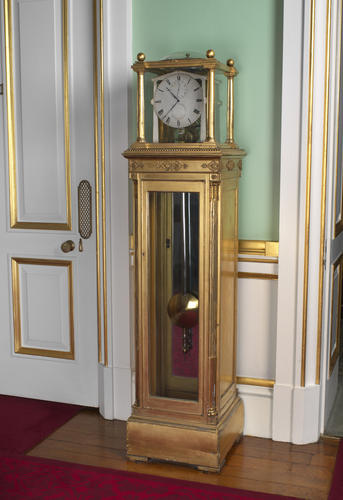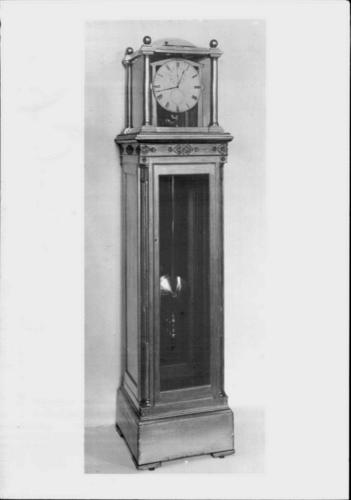-
1 of 253523 objects
Floor standing clock c.1800
Brass, silvered metal and blued steel | 38.1 x 29.3 x 21.6 cm (whole object) | RCIN 2869
-
One of two skeleton clocks in the Royal Collection designed by the polymath, Sir William Congreve, and made by John Moxon. Presently it is a brass locking plate striking skeleton clock with two weight driven trains, all of which are constructed within four raftered frames separated by turned brass pillars. Replacement dead beat escapement with jewelled pallets and a face of engraved silvered brass comprising a main dial and subsidiary seconds dial; two fleur de lys hands and a pointer of blued steel.
Originally the clock was of long duration with Congreve's 'extreme detached escapement'. The clock was repaired and considerably altered in 1879 by Charles Frodsham & Co. when the detached escapement was finally replaced by a with a dead beat escapement. At the same time the original pierced face was replaced by the present silvered dial.Provenance
Sir William Congreve was an artillery officer and prolific inventor. He is best known for the design of the military rocket, which was a significant advance on earlier black-powder rockets. Less used when overtaken by improved artillery and ordnance, they continued to find uses for flares and ship rescue. He is also usually considered the first modern inventor to propose plating warships with armour to protect against artillery fire. Upon the death of his father in 1814 (whose baronetcy he inherited), he became comptroller of the Royal Laboratory of Woolwich Arsenal between 1814-22 and from 1818 until his death, he was member of Parliament for Plymouth. He was also an Equerry to the Prince Regent in 1811. He was the inventor of the rolling ball clock and an 'extreme' detached escapement.
The clock was in use in the Library until Carlton House was demolished.
Included in the Pictorial Inventory of 1827-33 – RCIN 934768. The inventory was originally created as a record of the clocks, vases, candelabra and other miscellaneous items from Carlton House, as well as selected items from the stores at Buckingham House, the Royal Pavilion, Brighton, Hampton Court and Kensington Palace for consideration in the refurbishment of Windsor Castle.
-
Creator(s)
(clockmaker (original movement))(repairer)(nationality)Acquirer(s)
-
Medium and techniques
Brass, silvered metal and blued steel
Measurements
38.1 x 29.3 x 21.6 cm (whole object)
Alternative title(s)
Skeleton clock
Longcase clock

